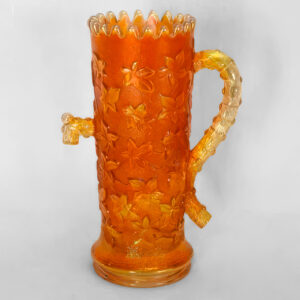About Us
The International Carnival Glass Association was formed to promote the study and education of the old glass known as carnival glass.
 Carnival glass can only be glass that has an iridescent finish, which is a rainbow effect, that radiates from the piece of glass. The color of the glass is very important. You can determine the color of the glass by looking at the base of the piece of glass through a bright light. The color of the glass itself can be clear, blue, green, purple, ice blue, sapphire blue, teal, ice green, and many other hues. The colors were produced by using different chemicals in the batch of glass.
Carnival glass can only be glass that has an iridescent finish, which is a rainbow effect, that radiates from the piece of glass. The color of the glass is very important. You can determine the color of the glass by looking at the base of the piece of glass through a bright light. The color of the glass itself can be clear, blue, green, purple, ice blue, sapphire blue, teal, ice green, and many other hues. The colors were produced by using different chemicals in the batch of glass.
The glass was pressed into intricately carved iron molds. When the glass had cooled enough, it was removed from the mold. The glass piece was then sprayed with a chemical solution, and the piece was reheated to permanently adhere the iridescence to the glass.
Clear glass can present different appearances with the solution of chemicals that was sprayed onto it. The most common color iridescence on the clear glass was marigold (that orange hue). Another solution produced a smoke color which radiates grayish or brownish coloring with other colorful shades. Peach opal was produced on clear glass, as well, but included in the batch was bone ash, and this when heated, creating a opaque white color mainly on the edges, but that can radiate deeper to the base. This was then sprayed with basically the marigold iridescence.
There are multitudes of shapes. Probably the most plentiful are bowls. Often plates were formed from the bowl molds. Other items found are water sets, punch sets, vases, table sets, bonbons, and many more. The value of carnival glass is determined by many factors – the shape, the color, the pattern, and the quality of the iridescence.
